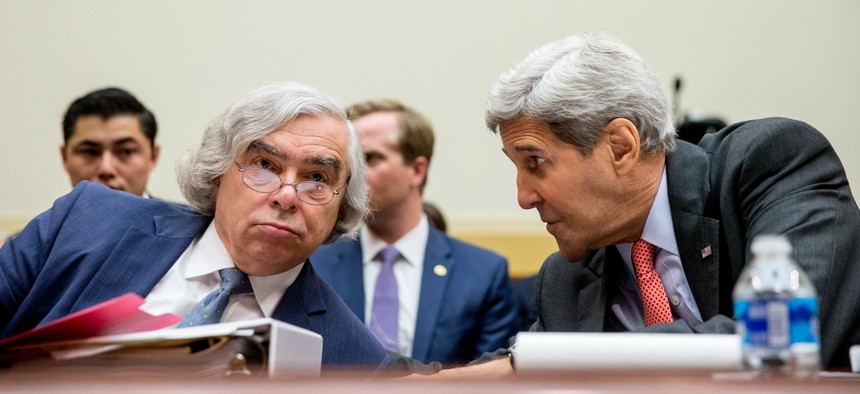
Energy Secretary Ernest Moniz, left, and Secretary of State John Kerry talk on Capitol Hill in Washington, Tuesday, July 28, 2015. Andrew Harnik/AP
9 Reasons the Iran Deal Makes Sense
Iran’s nuclear ambitions will long remain a cardinal challenge for the United States and its allies. The current agreement puts them in the best position to meet this challenge.
Having carefully reviewed the lengthy and complex agreement negotiated by the United States and its international partners with Iran, I have reached the following conclusion: If I were a member of Congress, I would vote yes on the deal. Here are nine reasons why.
1) No one has identified a better feasible alternative. Before negotiations halted its nuclear advance, Iran had marched relentlessly down the field from 10 years away from a bomb to two months from that goal line. In response, the United States and its partners imposed a series of sanctions that have had a significant impact on Iran’s economy, driving it to negotiate. That strategy worked, and resulted in a deal. In the absence of this agreement, the most likely outcome would be that the parties resume doing what they were doing before the freeze began: Iran installing more centrifuges, accumulating a larger stockpile of bomb-usable material, shrinking the time required to build a bomb; the U.S. resuming an effort to impose more severe sanctions on Iran. Alternatively, Israel or the United States could conduct military strikes on Iran’s nuclear facilities, setting back the Iranian program by two years, or perhaps even three. But that option risks wider war in the Middle East, an Iran even more determined to acquire a bomb, and the collapse of consensus among American allies.
2) At this point, a “better deal” is an illusion. One can always imagine a better deal. But if the U.S. Congress rejects this agreement and proposes to send Secretary of State John Kerry back to the negotiating table, he will most likely find no one else there. Partners who have negotiated and compromised over 20 months to achieve this accord will conclude that the U.S. government is incapable of making agreements. The international coalition will splinter and the sanctions regime will collapse, with Russia and China leading the way, but with France and Germany not far behind. The United States will have demonstrated that D.C. is in fact an acronym for Dysfunctional Capital. In comparison, Iran will appear to be the adult in this paring.
3) This agreement achieves America’s minimal essential objectives. In anearlier article for The Atlantic, I urged policymakers considering this agreement to “remember Nietzsche.” He famously observed that “the most common form of human stupidity is forgetting what one is trying to do.” In this case, the overriding objective of the United States has been to prevent Iran from acquiring a nuclear bomb. This agreement achieves that objective by stopping Iran verifiably and interruptibly short of a bomb. In fact, by eliminating two-thirds of Iran’s current centrifuges and 98 percent of its enriched-uranium stockpile, the agreement pushes Iran back at least a year from a bomb. If from that point Iran should seek to develop a nuclear weapon, the United States and its international partners will have ample time to discover the violation, consider their options, and act to stop it.
Opponents of this deal have misled some members of Congress with false claims and exaggerations about several technical details, including an International Atomic Energy Agency “secret deal” with Iran. Members of Congress interested in the facts should ask for a classified briefing from the American and Israeli intelligence communities. Both have concluded that this agreement puts Iran’s known nuclear program “in a box” for at least 10 to 15 years.
4) But what about secret facilities? The brute fact about unknown facilities is that we cannot know what we don’t know. No agreement can provide 100-percent confidence that Iran will not cheat at a secret facility. Indeed, no one can have 100-percent confidence today that Iran has not already built a nuclear bomb at a secret facility. What has prevented the Iranians from doing this so far has been Tehran’s judgment that such an undertaking would be discovered and that the United States would act decisively to deny them success. The keys to sustaining effective deterrence are (1) rigorous efforts by the intelligence agencies of the United States and its allies and (2) a credible military capability to act if Iran dashes toward a bomb.
Since the agreement imposes the most intrusive verification and inspection regime ever negotiated, it will significantly add to the ability of intelligence officials to discover any prohibited activity and enhance the legitimacy of U.S. or other countries’ military actions to stop Iran from developing nuclear weapons should it violate its commitments. Nonetheless, as experts and so-called experts debate a 24-day delay for direct inspections of suspicious activity, or insufficient answers about Iran’s earlier nuclear pursuits, no one should miss the larger truth: 99 percent of the work to assure that any Iranian cheating is discovered will be done by U.S. intelligence agencies and those of allies. That was true before the agreement and will remain so after—even though the new inspections regime will provide some helpful information and observations that would otherwise be unavailable.
5) But Israeli Prime Minister Benjamin Netanyahu asserts that this agreement “paves Iran’s path to a bomb.” Fortunately, this is not true; indeed, the opposite is closer to the mark. For a decade, Iran has been driving down a paved path to a bomb that allowed it to reach its current position: just two months away from that goal line. The agreement will push Iran back at least a year from this line, thus giving the United States and its allies more options to block Iran’s nuclear ambitions.
6) But at the end of 15 years, won’t Iran be free to resume its march toward a bomb? Yes, in the sense that the key physical constraints on Iran’s enrichment program will expire. But at that point, the United States and its partners will also be free to do whatever they choose. Everything the United States, Israel, and their allies can do today, they could do tomorrow or when the deal concludes. If, for example, the Iranians attempted to produce highly enriched uranium on the way to a bomb, the U.S. could stop them today—and as U.S. Secretary of Energy Ernest Moniz told Congress, it could do so tomorrow.
7) Most observers have failed to ask: Whose weapons, military exercises, and covert activities does this agreement not constrain? The answer is: those of the United States, Israel, and their allies. The clearest bottom line on this question comes from the individual who knows more about military options for blocking nuclear programs than anyone else on the planet. General Amos Yadlinis now chief of Israel’s leading national-security think tank. Until 2010, he was the head of Israel’s Military Intelligence Directorate, most recently serving under Netanyahu. In that role, he oversaw Israel’s bombing of Syria’s nuclear facility, an appropriate sequel to a mission he flew as a young pilot in 1981 that destroyed Iraq’s Osirak nuclear reactor. As Yadlin wrote recently, when the agreement expires, military action against Iran will be no more difficult, and indeed is likely to be easier, than it would be today, since there will be fewer Iranian targets and more will be known about them. In Yadlin’s words: “Military action against the Iranian nuclear program in 2025 would in all probability not be much more complicated or difficult than in 2015. … [T]he Iranian program will be reduced compared to what it is today, intelligence about it will be better, and it will be less immune than it is at present.”
8) But won’t Iran be free to continue all of its other nefarious activities that threaten the interests of the United States and its allies, including supporting terrorism, providing arms to Hezbollah and Hamas, and threatening Israel and U.S. allies in the Gulf? Yes, it will. But the United States, Israel, and Saudi Arabia will also be free to do everything that they are doing today—and more. Indeed, with the issue of Iran’s nuclear program set aside, they will have an opportunity to enlarge and enhance the collective effort to meet the challenges posed by Iran on other fronts.
9) So if the agreement does all of the above, why do so many people feel so uneasy about it? Beyond poisonous partisanship, the primary reason for discomfort with the current deal is that it surfaces ugly realities that most Americans who have not been following the Iranian nuclear story have never internalized. During the Bush administration, Iran mastered the technologies and know-how for manufacturing centrifuges and enriching uranium, thus overcoming the only high hurdle to building a bomb. This know-how is ingrained in the heads of thousands of Iranian scientists and engineers. Before 2003, Iran developed plans and tested explosives for a nuclear weapon. Over the past decade, Iran’s nuclear program advanced to the point at which it stands today: just two months away from one bomb’s worth of nuclear material. These are brute facts that no agreement, airstrike, or alternative anyone has proposed can erase.
In other words, it is impossible to “solve” the Iranian problem through this agreement or any feasible alternative. Iran’s nuclear ambitions will long remain a cardinal challenge for the United States and its allies—a challenge that will demand constant vigilance and a demonstrable readiness to do whatever is required to prevent Iran from acquiring nuclear weapons. The current agreement puts the United States in the best position to meet this challenge.
NEXT STORY: How To Avoid All-Out War in Cyberspace




